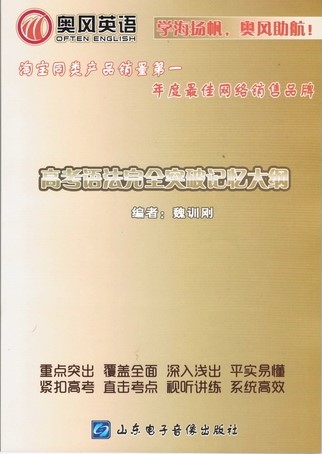

 本资料具体数据如下:
本资料具体数据如下:
规格:16开 页数:85 主编:魏训刚
本资料是奥风英语《高考语法完全突破》视频教程的配套资料。
奥风英语《高考语法完全突破》系列资料包括:
Ⅰ.《高考语法完全突破》视频教程光盘,魏训刚主讲
Ⅱ.《精编高考语法专项练习》(含答案及解析)
Ⅲ.《高考语法完全突破》视频教程记忆大纲
广受学习者好评,被誉为“高考语法三剑客”。视频教程可免费试听,在网上搜索一下即可找到。

第一讲:名词
一、名词的分类
|
名词 |
专有名词 |
|
普通名词 |
可数名词 |
个体名词 |
|
集体名词 |
|
不可数名词 |
物质名词 |
|
抽象名词 |
1.专有名词
表示人物、地方、国家、组织、机构等专有名称的词。
如:Tom, China, Christmas, the Great Wall
特性:
①原则上与其所表示的事物一一对应。
②实词的首字母要大写。
2.普通名词
泛指一类人或事物的名称的词。
如:actor, dictionary, money, weather
分类:
可数名词 如:dictionary, island
不可数名词 如:fun, money, furniture
可数名词
分类:个体名词和集体名词
个体名词:表示单个的人或事物的名称的词。
如:garden, actor, hammer
集体名词:表示由若干人或事物组成的集合体的名称的词。
如:family, class, staff, team
不可数名词
分类:物质名词和抽像名词
物质名词:表示构成世上万物的物质或材料名称的词。
如:cotton, water, ink, wood
抽像名词:表示性质、行为、状态、情感等抽像概念名称的词。
如:freedom, fun, health, happiness, anger, value
二.名词的数
1.规则名词复数的构成。
(1)一般情况下直接加-s。在清辅音后读/s/,在元音和浊辅音后读/z/。
如:cooks, canals, monkeys
(2)以s, x, sh, ch结尾的名词,直接加-es,读/?z/。
如:buses, brushes, coaches
(3)以辅音字母+y结尾的名词,y变成i,再加es。
如:story-stories, county-counties
注意:以元音字母+y结尾的词,直接加s,如:boy-boys, rays, bays
(4)以o结尾的名词。
①一般直接加s读/z/。
如:radio-radios, photo-photos, kilo-kilos, zoo-zoos,
piano-pianos, bamboo-bamboos, studio-studios
②少数加es,读/z/。
如:hero-heroes, tomato-tomatoes, potato-potatoes, negro-negroes
③两种情况均可。
如:zero-zeros/zeroes, motto-mottos/mottoes, volcano-volcanos /volcanoes
(5)以f/fe结尾的词
①一般将f/fe变为v,再加es,读/vz/。
如:wife, knife, wolf, thief, shelf, self, life, half, leaf, loaf
|
妻子(wife)持刀去宰狼(wolf),
小偷(thief)吓得发了慌;
躲在架(shelf)后保己(self)命(life),
半(half)片树叶(leaf)遮目光。 |
②有些直接加s,读/s/。
如:roof-roofs, gulf-gulfs, safe-safes, chief-chiefs, belief-beliefs
③个别有两种形式。
如:handkerchief-handkerchiefs/handkerchieves
2.不规则名词复数的构成。
(1)变内部元音。
如:man-men, goose-geese, tooth-teeth
(2)单复数同形。
如:fish, sheep, deer, Chinese, swine, jin(斤), yuan(元), means
(3)无规则变化。
如:child-children, mouse-mice, medium-media,
bacterium-bacteria,ox-oxen, phenomenon-phenomena
3.复合名词复数的构成
(1)有中心词(主要名词)时,通常将中心词变为复数。
如:story-teller →story-tellers, mother-in-law→mothers-in-law,
passer-by→passers-by, looker-on→lookers-on
(2)没有(主要)名词时,在词尾加s。
如:grown-up→grown-ups, go-between→go-betweens
(3)由man/woman加其他名词构成的复合名词变复数时前后都变。
如:man driver-men drivers, woman writer-women writers
注意::boy/girl student - boy/girl students , German-Germans
(4)字母、符号、数字等复数的构成通常在其后加’s。
如:There are two t’s in teeth.在teeth这个单词里有两个t。
There are three 8’s in this number.在这个数字里有3个8。
4.表示“某国人”的单、复数变化。
“中日瑞不变英法变,其它国把-s加后面”。
如:
Chinese---Chinese Japanese--Japanese Swiss---Swiss
Englishman---Englishmen Frenchman---Frenchmen
American---Americans Australian---Australians Canadian---Canadians
Korean---Koreans Russian---Russians Indian---Indians
三、名词所有格
名词所有格表示所有关系。
如:Tom’s cat,Mary’s perfume
分类:
’s所有格, of所有格和双重所有格
1.’s所有格
(1)’s所有格的构成
通常在名词后加’s,如果词尾已有s,则直接加’。
如:the girl’s dolls,Tom’ s piano,the students’ books
注意:Charles’ bag/Charles’s bag
(2)’s所有格的运用
①多用于表示有生命的人或动物的名词。
如:Jim’s bike, Mary’s skirt
②也可用于表示时间、空间、距离、价格、重量等无生命的名词。
如:the city’s history, three days’ time, the book’s author,
today’s newspaper, an hour’s drive
比较:
Mary and Jean’s room两人共有的房间
Mary’s and Jean’s rooms两人各自的房间
(3) ’s所有格后名词的省略
①前面出现的名词,可以省略。
如:This MP5 is Mary’s (MP5).
②其后的名词表示某人的家、办公场所时可以省略。
如:He stayed at John’s last night.
The boy went to the barber’s.
2. of所有格
(1) of所有格的运用
①主要用于无生命的名词。
如:the leg of the table,the top of the mountain
②也可用于表示人或动物的名词。
如:the pride of her family,the daughter of a policeman
(3).’s所有格和of所有格的比较
①两者很多情况下可以通用。
如:the film’s end=the end of the film,
the young people’s education=the education of the young people
②表示类别属性时通常用’s。
如:women’s clothes, children’s books
③名词以“the+形容词/分词”的形式出现时,通常用of所有格。
如:the problem of the young, the children of the killed
3.双重所有格
双重所有格是’s所有格和of所有格的结合,通常表示“许多中的一个或一部分”。
如:a friend of Mary’s, some books of our teacher’s
四.不可数名词的量化表达
不可数名词没有单复数的形式变化,表示不可数名词的量常用以下三种方法:
(1)用some, much, a little, little, a lot of, lots of, plenty of等来表示。
如:
much water;a lot of money; a little milk;plenty of rice;some orange juice
(2).用容器来表示。
如:
a cup of coffee;two pots of water;ten bags of rice;six boxes of ink
(3)用计量单位来表示。
如:
a loaf/slice of bread; a grain of rice; a piece of furniture; a large sum of money
五.名词的语法功能
1.作主语
如:A good teacher must be patient.
2.作宾语
如:I like English.
She bought an umbrella.
3.作表语
如:His uncle is an engineer.
4.作定语
如:It’s a shoe factory.
5.作宾补
如:They all call him a playboy.
6.作状语
如:The meeting lasted two hours.
I’ve told you many times.
7.名词作定语的注意事项:
(1)名词作定语时通常用单数
如:shoe factory, telephone number
(2)“数词-名词”结构作定语时,名词也要用单数。
如:He had an eight-hour sleep (=He had eight hours’ sleep)
a nine-year-old girl (The girl is nine years old.)
(3)少数名词习惯上用复数。
如:sports car, parents meeting
(本资料为魏训刚老师《高考语法完全突破》配套资料)
 您现在的位置: 奥风英语 > 其他科目 > 奥风图书 > 正文
您现在的位置: 奥风英语 > 其他科目 > 奥风图书 > 正文